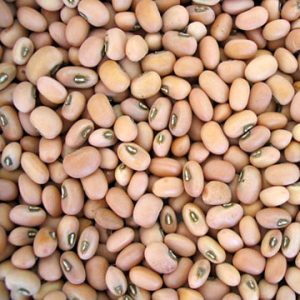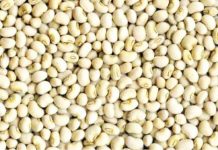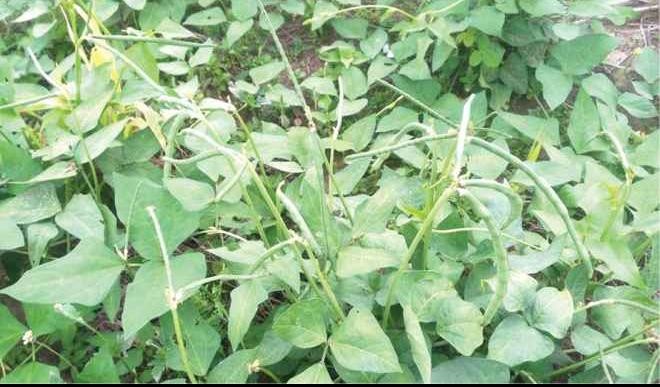 Choice of land
Choice of land
Cowpea requires a good, well-drained soil. In the forest zone, cowpea may not be grown as the first crop on lands that have been in fallow for more than 10 years. Cowpea should be rotated with other crops, e.g., maize, after one or two successive croppings.
Land preparation
(i) Site must be stumped, plowed, and harrowed into a clean seed bed. In sole cropping, it is not necessary to make ridges or heaps, but in mixed cropping, cowpea may be planted on ridges or heaps. Contour bunds are advised on sloping sites to check erosion.
(ii) If the land had been previously cropped, these land preparation requirements may not be necessary. ‘minimum tillage practice can be adopted. When minimum tillage is practiced, spray Paraquat (Gramoxone™) at 240 ml–320
ml/20 liters of water (3–4 liters/ha), depending on weed situation, to clear the vegetation. When there are stubborn
weeds e.g. Imperata cylindrica (speargrass) and sedges, use Glyphosate (Round-up) at 5–6 litres/ha. If Round-up is used, the farmer is advised to wait for about 3 weeks before planting cowpea.
Recommended varieties
(i) Ife Brown (IRAWO), brown seeded, (75 days maturity).
(ii) Ife Bimpe, Brown seeded, (85 days maturity).
(iii) IT 84E–124, Brown seeded, (60 days maturity).
(iv) K-28, Brown seeded, (about 75 days maturity).
(v) IT 84E–2246-4, Brown seeded.
Certified seeds are available from state Ministries of Agriculture and Natural Resources, the National Seed Service, and registered private seed companies.
There are some dual-purpose (grain and fodder) varieties for dry Savanna areas
Time of planting
SAVANNA ZONE
For medium/late maturing varieties (70–86 days), plant from late July to mid-August. For early maturing varieties (55–69 days), commencing planting from mid-August to the end of August.
FOREST ZONE
For medium/late maturing varieties, planting should commence from mid-August to early September, depending on the onset of late season rains.
Seed rate and plant population
SEED RATE
Approximately 25–30 kg/ha (good and viable seeds).
SPACING
20 x 75 cm for erect varieties and 50 x 75 cm for spread types. 2 seeds/hole, 4–5cm deep.
Fertilization
SAVANNA ZONE
Use 50–100 kg/ha (1–2 bags) of single superphosphate depending on the level of P-deficiency or 100 kg/ha (2 bags) of NPK 15:15:15.
FOREST ZONE
Use 50 kg/ha (1 bag) of single superphosphate on land under continuous cropping. Broadcast the fertilizer and harrow it before planting.
Alternatively, apply 150kg/ha of NPK 15:15:15 in the same way.
Weed control
HAND WEEDING
Give minimum of 2 hoe-weedings the first 3 weeks after planting and the second 4–5 weeks after planting. and leaving them in the field to dry.
CHEMICAL CONTROL
CLEAN SEED BED: Use Galexet™ 200–250 ml/20L of water as pre-emergence herbicide not later than the second day after planting. Pendimethalin (Stomp) at the rate of 200–250 ml/20L of water can be used to control corn grass (Rottboellia cochinchinensis).For maximum activity of the herbicide, the farmer must make sure thet there is enough moisture in the soil before application.
MINIMUM TILLAGE: Where minimum tillage is adopted, use Paraquat (GramozoneTM) at 200 ml/20L of water to eliminate emerging weeds.
Diseases and pest control
BROWN BLOTCH
Use Benlate at the rate of 15g/10L of water; 2–3 applications are required, beginning from flowering. For good control of insect pests as well as brown blotch disease, a mixture of Benlate® and the appropriate insecticide will produce a satisfactory result.
Farmers can use high volume, ultra-low-volume or electrodyne formulations and their respective a sprayers.
NEMATODES
Cowpea should follow early season cereals such as maize or rice on the same land. If possible, do not grow more than two successive crops of cowpea on the same land. Also do not grow cowpea after other crops susceptible in root-knot nematodes, such as tomatoes, kenaf, and leaf-vegetables.
INSECTS
Flower thrips, pod borers and pod sucking bugs: To obtain good yields, flower thrips and pod borers must be controlled with any of the broad spectrum insecticides.
• Karate™ EC 80 ml/20 L of water (1 L/ha), Sherpa plus™ 80 ml/20 L of water or Cymbush super™ ED at 1.0 litre/ha. or Karate™ super Ed at 1.0 L/ha. Spraying must begin from 5 weeks after planting or at flower initiation at 7–10 days intervals with a maximum or 3 or 4 sprayings. However, aphid infestation occurs much earlier than 5WAP, Pirimor™ should be sprayed at 2 gm/20 L of water for aphid control or 40 ml/20L of water of Karate™ to control foliage beetles or aphids.
RODENTS
Damage from rats can be minimized by keeping the plot and boundaries weed-free. In addition, traps may be used, if need be.
Harvesting
Prompt and early harvesting is advised. Harvest when pods are dry. Dry pods should not be left long in the field to minimize cowpea weevil infestation and to avoid bird attack and shattering.
If labor is expensive or not available, harvesting can be done by cutting all the plants at the base
Afterwards, they are beaten manually or mechanically threshed and winnowed.
Expected yield 700–1000 kg/ha are expected on a well-managed field and under good rainfall distribution.
Storage
(i) Dry the seeds properly to 10–12% moisture content (a properly dried seed makes a cracking sound when crushed with the teeth).
(ii) Prior to storage, fumigate with Gastoxin™ in airtight containers or bags.
(iii) While in storage in airtight containers such as drums, tins, or clay pots, double or triple polyethylene bags, periodical checking of seeds is necessary. Fumigate with Phostoxin™ at the rate of 1 tablet/100 kg. This will protect the seeds from bruchid damage during storage. Do not keep fumigated cowpea seeds in the sleeping room or close to living quarters. Fumigated seeds should be exposed to open air for 2–3 days before processing for consumption.





